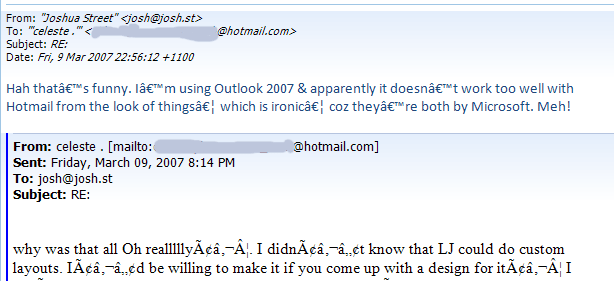Forgetting to speak
18 Mar 2007Two articles from The Sun-Herald & The Age today contrasted starkly and got me sufficiently upset. An Australian company unveils a brain interface system for application with computer games, which is quite geeky and, quite frankly, very cool.
“US reports suggested children took to the system more quickly than adults who were less able to engage in fantasy.”
Yes, okay. I’d love to be able to use this to get things done in Photoshop more quickly — its applications seem primarily creative in nature rather than simply replacing a keyboard, etc., but that’s not really what upset me.
Excuse The Age’s horrifically sensationalistic “TV blamed for rise in child-speech problems” headline, but the actual article isn’t that rubbish. Essentially, it attributes an anecdotal rise in speech problems and a quantifiable detection-associated rise in referrals to speech pathologists.
“There is good data to show that the more often you sit around a dining room table and have a conversation around a meal, the better the language development of children,” he said.
Psychologists in Britain were running a campaign called Back to the Table to try to get families to share meals together around a table on a regular basis.
I’m not so concerned by it because I don’t have kids. I’m concerned by it because I deal with kids probably just enough to notice.
Funny how two articles so often crop up on the same day so starkly undermining one another’s message!
For all the rhetorical garbage that media studies & digital culture (described by a lecturer as having emerged from sociology, only without method — I jest not) spew out about how we should eschew the pessimistic futurists that tell us new media is only serving to distance us all… they are, in my view, quite plainly ignoring at least some of the impacts of these emerging mediums.
This is frustrating. I want to believe technology is pedagogically advantageous, but struggle immensely with its application even where there are fantastic (technology, not content) resources available–and I’m a geek. Admittedly, that’s no qualification to teach, but it should at least mean some kind of creativity where the two meet. Or not.
Mostly, though, this isn’t about technology at all. It’s about its effects, intended or otherwise — and particularly for children. I don’t even see the speech problems so much as the things that surround them, in the forms of attention span & relational difficulties with both friends (less common) and family. Please be praying for wisdom in thinking through how best to deal with these issues.
(Yes, I am still saying I want to do secondary teaching. I feel like I’m slowly being changed to have an openness to either secondary or primary, though. If you feel so inclined, pray about that, too!)

